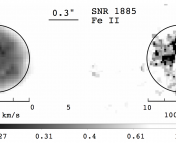Title: Revisiting the dust destruction efficiency of supernovae
Authors: F. D. Priestley, H. Chawner, M. Matsuura, I. De Looze, M. J. Barlow, H. L. Gomez
First Author’s Institution: School of Physics and Astronomy, Cardiff University, Queen’s Buildings, The Parade, Cardiff CF24 3AA, UK
Status: Published in MNRAS [open access]
In Dust We Trust
What could be more exciting than dust? Maybe dust in space?! Okay, perhaps even space dust isn’t the most enthralling subject upon first glance, but dust is arguably the most underappreciated topic in astronomy. Measurements of dust can tell us about magnetic fields, temperatures, and even the 3D morphology of structures in our galaxy! An image of dust emission from the Andromeda galaxy is shown in Figure 1. Over the next decade, dust will play a crucial role in helping us understand the 3D structure of gas in our galaxy for the first time ever (for example, check out the recent discovery of the Radcliffe Wave). Dust also tells us a whole lot about the chemistry that operates during star and planet creation and is key to studying how complex molecules, like those that make up you and me, were formed. In today’s study, though, the author’s examine how this dust can be destroyed by a violent explosion of matter and energy known as a supernova.

X(-ray) Marks the Spot
Right: X-ray emission from Chandra for the same supernova remnant. The shell of the remnant is also clearly visible in X-rays. Image credit: Figure 1 in the paper.
To do so, the authors examine three nearby supernova remnants (SNRs): G11.2-0.3, G27.4+0.0, and G29.7-0.3. Nearby is relative here; all three remnants are located between 4 and 6 kiloparsecs away from us (nearly 13,000 to 20,000 light years away!). For comparison, the nearest stars to us are only a few light years away. They begin their analysis by identifying the shell of each SNR. The shell refers to material swept up by the shock from a supernova explosion – think of a bunch of bulldozers pushing material out from the supernova in a spherical pattern. This shell is a 3D object, but we can only observe it in 2D on the sky. This makes it appear like a ring, since we look through more material near the edges. In Figure 2, we can see the shell of G11.2-0.3 observed at two different wavelengths. After determining the shell boundary in X-rays, the authors can then also use the observed X-ray emission to calculate the temperature and density of the gas in the shell. X-rays are responsible for tracing the hot gas in the supernova remnant – think millions of degrees Kelvin!
Getting a Measure of Dust
With the spatial extent and the properties of the shell identified in X-rays, the authors move on to examining the infrared emission to understand the dust in the region. Based on Figure 3, it can be seen that the best fit using only the assumed parameters from X-ray data tracing the hot gas (shown on left) does a poor job of matching the data. However, the authors find that including another component to their model – a sizable quantity of “cold” dust – allows for a much better fit to the data. This proves to be the case in all three of the SNRs that they study.
Because of this, they argue that traditional models, such as the one used to produce the fit on the left of Figure 3, significantly underestimate the amount of dust in a SNR. The two-component model predicts a substantially higher dust mass in the SNRs than the traditional one-component models. In other words, they contend that the ability of supernovae to destroy dust has been vastly overestimated, making models assume that far less dust remains after a supernova than actually does. They associate this large additional quantity of cold dust with previously undetected regions of cold gas (which doesn’t show up in X-rays!) that have already passed through the supernova shockwave.
Right: Best-fit SED for G11.2-0.3 using carbon dust grains with the extra cold component of dust added on. The red line indicates the warm dust already accounted for by the model, the blue line indicates their best fit to the cold dust component, and the black line indicates the sum of the two. Image credit: Figures 3 and 6 in the paper.
Why Does This Matter?
Dust is extremely important for many physical processes in the interstellar medium: allowing star-forming regions to cool and contract, building planets, and others. Supernovae are also crucial for regulating star formation and galaxy evolution, and they occur quite often throughout the lifetime of a galaxy. Models for dust destruction from supernovae are commonly used in high-resolution simulations of the interstellar medium that represent our best understanding of star formation to date. If such models and simulations significantly overestimate the power of supernovae to destroy dust (and therefore underestimate the amount of dust remaining after a supernova), the results from these simulations may not be on as solid ground as we first thought. New physics may be lurking in the shadows, waiting to be understood!
Astrobite edited by Spencer Wallace
Featured image credit: NASA/JPL-Caltech/K. Gordon (University of Arizona)




